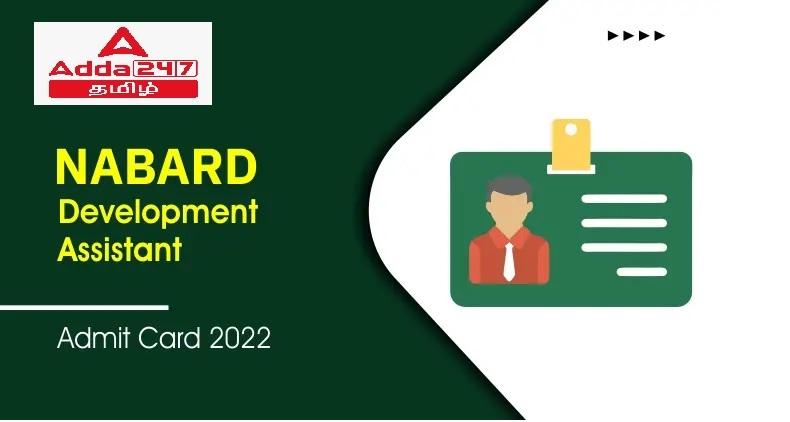Table of Contents
NABARD மேம்பாட்டு உதவியாளர் அனுமதி அட்டை 2022: விவசாயம் மற்றும் ஊரக வளர்ச்சிக்கான தேசிய வங்கி, 2022 ஆம் ஆண்டு அக்டோபர் 29 ஆம் தேதி NABARDன் அதிகாரப்பூர்வ இணையதளத்தில் முதல்நிலைத் தேர்வுக்கான NABARD மேம்பாட்டு உதவியாளர் அனுமதி அட்டை 2022ஐ வெளியிட்டுள்ளது. ஆட்சேர்ப்புக்கு வெற்றிகரமாக விண்ணப்பித்த அனைவரும் NABARD மேம்பாட்டு உதவியாளர் 2022 ஆம் ஆண்டுக்கான NABARD டெவலப்மென்ட் அசிஸ்டெண்ட் பிரிலிம்ஸ் அட்மிட் கார்டை இப்போது பதிவிறக்கம் செய்யலாம். NABARD டெவலப்மெண்ட் அசிஸ்டெண்ட் அட்மிட் கார்டு 2022ஐப் பதிவிறக்குவதற்கான கடைசி தேதி நவம்பர் 6, 2022 ஆகும்.
Fill the Form and Get All The Latest Job Alerts
NABARD மேம்பாட்டு உதவியாளர் அனுமதி அட்டை 2022 வெளியிடப்பட்டது
NABARD மேம்பாட்டு உதவியாளர் அனுமதி அட்டை 2022 நபார்டின் அதிகாரப்பூர்வ இணையதளத்தில் வெளியிடப்பட்டுள்ளது. விண்ணப்பதாரர்கள் தங்கள் NABARD டிஏ அட்மிட் கார்டு 2022ஐ எந்த தாமதமும் இன்றி சரியான நேரத்தில் பதிவிறக்கம் செய்ய அறிவுறுத்தப்படுகிறார்கள். NABARD டெவலப்மென்ட் அசிஸ்டெண்ட் பிரிலிம்ஸ் தேர்வு நவம்பர் 6, 2022 அன்று நடைபெற உள்ளது. NABARD மேம்பாட்டு உதவியாளர் அழைப்புக் கடிதம் தொடர்பான தேவையான அனைத்து விவரங்களும் இடுகையில் கீழே கொடுக்கப்பட்டுள்ளன.
NABARD மேம்பாட்டு உதவியாளர் அனுமதி அட்டை 2022: முக்கியமான தேதிகள்
NABARD டெவலப்மெண்ட் அசிஸ்டெண்ட் அட்மிட் கார்டு 2022 தொடர்பான அனைத்து முக்கியமான தேதிகளையும் விண்ணப்பதாரர்கள் பின்வரும் அட்டவணையில் இருந்து பார்க்கலாம்.
| NABARD Development Assistant Recruitment 2022: Important Dates | |
| NABARD Development Assistant Recruitment 2022 | 15th September 2022 |
| NABARD Development Assistant Admit Card 2022 | 29th October 2022 |
| NABARD DA Prelims Exam | 6th November 2022 |
NABARD மேம்பாட்டு உதவியாளர் அனுமதி அட்டை 2022 இணைப்பு
NABARD டெவலப்மெண்ட் அசிஸ்டெண்ட் அட்மிட் கார்டு 2022 இணைப்பு 29 அக்டோபர் 2022 அன்று செயல்பாட்டில் உள்ளது, எனவே NABARD DA ஆட்சேர்ப்புக்கு பதிவு செய்த அனைத்து விண்ணப்பதாரர்களும் இப்போது தங்கள் NABARD Development Assistant Prelims Admit Card 2022 ஐ பதிவிறக்கம் செய்ய முடியும். விண்ணப்பதாரர்கள் தங்கள் பதிவு எண் மற்றும் கடவுச்சொல்லை வைத்திருக்க வேண்டும். அல்லது அவர்களின் NABARD மேம்பாட்டு உதவியாளர் அனுமதி அட்டை 2022 ஐ பதிவிறக்கம் செய்ய பிறந்த தேதி. அவர்களின் NABARD மேம்பாட்டு உதவியாளர் அனுமதி அட்டை 2022 ஐ பதிவிறக்கம் செய்வதற்கான நேரடி இணைப்பு கீழே கொடுக்கப்பட்டுள்ளது.
NABARD Development Assistant Admit Card 2022
NABARD மேம்பாட்டு உதவியாளர் அனுமதி அட்டை 2022 ஐ பதிவிறக்கம் செய்வது எப்படி?
1.NABARD இன் அதிகாரப்பூர்வ வலைத்தளத்தைப் பார்வையிடவும் @https://www.nabard.org அல்லது மேலே கொடுக்கப்பட்டுள்ள இணைப்பைக் கிளிக் செய்யவும்
2.முதல் பக்கத்தில், உங்கள் திரையின் மேற்புறத்தில் தொழில் குறித்த அறிவிப்பைக் காண்பீர்கள்
3.தொழில் அறிவிப்பைக் கிளிக் செய்யவும், தொடர இங்கே கிளிக் செய்யவும்
4.“தொடர இங்கே கிளிக் செய்யவும்” என்பதை அழுத்திய பிறகு, NABARD மேம்பாட்டு உதவியாளர் அனுமதி அட்டை 2022 இணைப்பைக் காண்பீர்கள்.
5.இப்போது NABARD DA அட்மிட் கார்டு இணைப்பைக் கிளிக் செய்யவும்
6.இப்போது பதிவு எண் மற்றும் பிறந்த தேதி/கடவுச்சொல்லை நிரப்பவும்
7.நீங்கள் ரோபோ இல்லை என்பதை நிரூபிக்க கேப்ட்சா குறியீட்டை உள்ளிட்டு உள்நுழைவு பொத்தானைக் கிளிக் செய்யவும்.
8.NABARD DA அட்மிட் கார்டு 2022 உங்கள் திரையில் தோன்றும்
9.அச்சு பொத்தானைக் கிளிக் செய்து, உங்கள் அட்மிட் கார்டைப் பதிவிறக்கவும்
TNPSC Field Surveyor & Draftsman Hall Ticket 2022 Out
NABARD மேம்பாட்டு உதவியாளர் தேர்வு நடைபெறும் இடத்திற்கு தேவையான ஆவணங்கள்
பரீட்சார்த்திகள் தங்களுடன் பரீட்சை மண்டபத்திற்கு பல்வேறு முக்கிய பொருட்களை பரீட்சை நடைபெறும் இடத்திற்கு கொண்டு செல்ல வேண்டும். அனைத்து முக்கியமான விஷயங்களின் பட்டியல் கீழே குறிப்பிடப்பட்டுள்ளது.
1.அட்மிட் கார்டு: விண்ணப்பதாரர்கள் NABARD மேம்பாட்டு உதவியாளர் அனுமதி அட்டை 2022ஐ எடுத்துச் செல்ல வேண்டும்.
2.ஆவணங்கள்: விண்ணப்பதாரர்கள் புகைப்படத்துடன் கூடிய பான் கார்டு/பாஸ்போர்ட்/ஆதார் அட்டை/இ-ஆதார் கார்டு போன்ற அசல் புகைப்பட அடையாளச் சான்றிதழை எடுத்துச் செல்ல வேண்டும். புகைப்படத்துடன் கூடிய நிரந்தர ஓட்டுநர் உரிமம்/வாக்காளர் அட்டை/வங்கி பாஸ்புக் புகைப்படத்துடன் கூடிய புகைப்படம்/அதிகாரப்பூர்வ லெட்டர்ஹெட்டில் அரசிதழில் வெளியிடப்பட்ட அடையாளச் சான்று அங்கீகரிக்கப்பட்ட கல்லூரி/பல்கலைக்கழகம்/ஊழியர் ஐடி/பார் கவுன்சில் அடையாள அட்டை மற்றும் புகைப்படத்துடன் வழங்கப்பட்ட புகைப்படம்/செல்லுபடியாகும் சமீபத்திய அடையாள அட்டையுடன் அதிகாரப்பூர்வ லெட்டர்ஹெட்டில் மக்கள் பிரதிநிதியால் வழங்கப்பட்ட புகைப்படம்/புகைப்பட அடையாளச் சான்று.
3.பாஸ்போர்ட் அளவு புகைப்படம்: விண்ணப்பதாரர் 2 பாஸ்போர்ட் அளவு புகைப்படங்களை வைத்திருக்க வேண்டும். விண்ணப்பப் படிவத்துடன் இணைக்கப்பட்டுள்ள புகைப்படத்துடன் புகைப்படம் பொருந்த வேண்டும்.
TNTET Paper 2 Hall Ticket 2022
NABARD மேம்பாட்டு உதவியாளர் அனுமதி அட்டை 2022 இல் குறிப்பிடப்பட்டுள்ள விவரங்கள்
NABARD டெவலப்மெண்ட் அசிஸ்டெண்ட் அட்மிட் கார்டு 2022ஐப் பதிவிறக்கிய பிறகு, அட்மிட் கார்டில் அச்சிடப்பட்டுள்ள அனைத்து விவரங்களும் சரியாக உள்ளதா இல்லையா என்பதை விண்ணப்பதாரர்கள் சரிபார்த்து, ஏதேனும் பிழையைக் கண்டால், முடிந்தவரை விரைவில் சம்பந்தப்பட்ட அதிகாரிக்கு தெரிவிக்கவும்.
- Applicant’s Name
- Gender (Male/ Female)
- Applicant Roll Number
- Applicant Photograph
- Exam Date and Time
- Candidate’s Date of Birth
- Father’s/ Mother’s Name
- Category (ST/ SC/ BC & Other)
- Name of Exam Centre
- Test Centre Address
- Post Name
- Examination Name
- Time Duration of the Exam
- Exam Centre Code
- Essential instructions for the examination
- Empty Box for Signature of Candidate
- Empty Box for Signature of Invigilator
NABARD DA முதல்நிலை தேர்வு முறை 2022
NABARD DA தேர்வில் தோற்றவிருக்கும் விண்ணப்பதாரர்கள் தேர்வு நடைபெறும் இடத்திற்குச் செல்வதற்கு முன், ப்ரீலிம்ஸ் தேர்வு முறையைச் சரிபார்க்க வேண்டும். NABARD முதல்நிலை தேர்வு முறை கீழே கொடுக்கப்பட்டுள்ளது:
| Section | No. Of Questions | Maximum Marks | Time Duration |
| English Language | 40 | 40 | 1 hour |
| Numerical Ability | 30 | 30 | |
| Reasoning | 30 | 30 | |
| Total | 100 | 100 |
NABARD மேம்பாட்டு உதவியாளர் அனுமதி அட்டை 2022: தேர்வு செயல்முறை
கீழே கொடுக்கப்பட்டுள்ள 3 கட்டங்களைக் கொண்ட NABARD DAக்கான தேர்வு செயல்முறையை விண்ணப்பதாரர்கள் சரிபார்க்க வேண்டும்:
1.பிரிலிம்ஸ் தேர்வு
2.முதன்மைத் தேர்வு
3.மொழி திறன் தேர்வு
NABARD மேம்பாட்டு உதவியாளர் அனுமதி அட்டை 2022 FAQs
Q1. NABARD மேம்பாட்டு உதவியாளர் அனுமதி அட்டை 2022 எப்போது வெளியாகும்?
பதில் NABARD மேம்பாட்டு உதவியாளர் அனுமதி அட்டை 2022 அக்டோபர் 29, 2022 அன்று வெளியிடப்பட்டது.
Q2. NABARD மேம்பாட்டு உதவியாளர் அனுமதி அட்டை 2022ஐ எவ்வாறு சரிபார்க்கலாம்?
பதில் NABARD மேம்பாட்டு உதவியாளர் அட்மிட் கார்டு 2022ஐ மேலே கொடுக்கப்பட்டுள்ள இணைப்பில் பார்க்கலாம்.
Latest Govt job Notification:
***************************************************************************
இது போன்ற தேர்விற்கான தகவல் மற்றும் பாடக்குறிப்புகளை பெற ADDA247 தமிழ் செயலியை பதிவிறக்கம் செய்யுங்கள்
To Attempt the Quiz on APP with Timings & All India Rank,
Download the app now, Click here
Adda247 பயன்பாட்டில் இந்த வினாடி வினாவை முயற்சிக்க இங்கே கிளிக் செய்து அகில இந்திய தரவரிசையைப் பெறுங்கள்
| Adda247 TamilNadu Home page | Click here |
| Official Website=Adda247 | Click here |
Use Code:ME15(15% off on all)

***************************************************************************
*இப்போது உங்கள் வீட்டில் தமிழில் நேரடி வகுப்புகள் கிடைக்கின்றன*
*பயிற்சி மட்டுமே தேர்வுர உங்களுக்கு உதவ முடியும் | Adda247 தமிழ் மூலம் உங்கள் பயிற்சியை இப்போது தொடங்கவும்*
Adda247App | Adda247 Tamil Youtube
Tamil Engineering Classes by Adda247 Youtube link
Adda247 Tamil telegram group –Tnpsc sure shot selection group
Instagram = Adda247 Tamil




